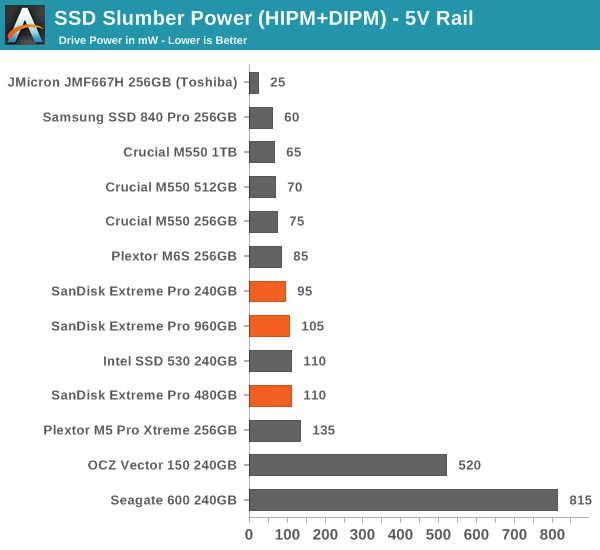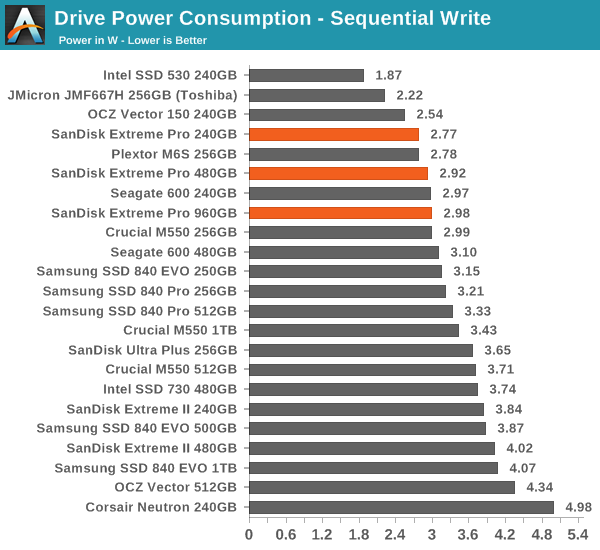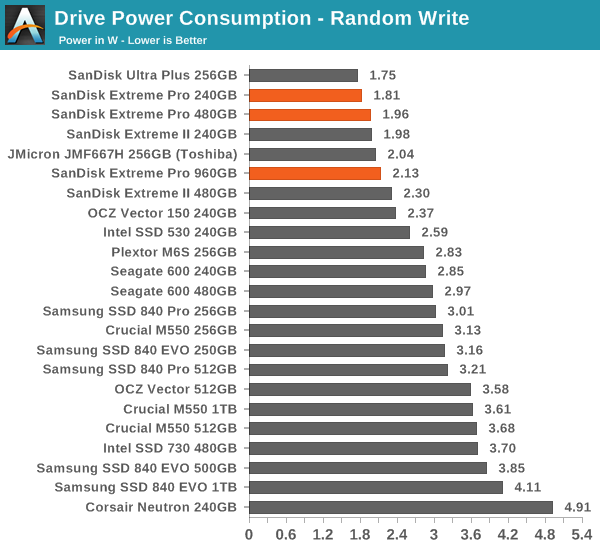SanDisk Extreme Pro SSD (240GB, 480GB & 960GB) Review: The Fastest Just Got Faster
by Kristian Vättö on June 16, 2014 4:00 PM EST- Posted in
- Storage
- SSDs
- SanDisk
- Extreme Pro
Power Consumption
The Extreme Pro supports both DevSLP and slumber power. We are still working on a way to measure DevSLP power but in the mean time, we have to rely on slumber power measurements. Slumber power consumption is quite average -- it's not the most efficient drive we have tested but 100mW is pretty typical for a high performance SSD. What is awesome, however, is the load power consumption, because the drive doesn't exceed 3W in any case and stays at around 2W when under random write workload. Out of the high performance SSDs, the Extreme Pro is definitely the most power efficient because it supports DevSLP and slumber states, yet the load power consumption is very low too.













85 Comments
View All Comments
ninjag - Thursday, June 19, 2014 - link
Where can I find these 10000% washing machines? I have been tracking this market for years, and I am so tired of incremental 5% gains on washing machine silicon. WE WANT INNOVATION!!!brucek2 - Tuesday, June 17, 2014 - link
Its discussions like this that make it hard for me to get a feel for whether it would matter to me or not.On the one hand, 162% sounds plenty substantial. I do not want to spend 162% more immersion-breaking time twiddling my thumbs waiting for the next level to load, let alone 162% more time to get through a compile so I can meet my next deadline.
On the other hand, waiting 1/1,000th of a second does not actually sound any faster to me than waiting 1/4,000th of a second (these are the "average service times" in the benchmark), because I know my personal threshold for perceiving laggy response kicks in at around 0.1 seconds.
So where does this leave me? Not sure really but in the case of doubt it probably goes to spend more. The extra $100-$200 of potential hardware savings would be eaten up quickly in my time to research it much further, to end up ordering & installing & migrating to another drive sooner than I otherwise would have, or if I really did end up twiddling my thumbs more.
But never fear MyrddinE, I'm still not buying the 99.8% pure unicorn dust super connect audio cables.
mickulty - Tuesday, June 17, 2014 - link
There are plenty of use cases where every little helps - a 5% overclock, assuming linear scaling, would shave ~8.5 minutes off a 3 hour video transcoding task for example.UltraTech79 - Sunday, June 29, 2014 - link
See but actual users do not do "blind tests" they do actual tests for their servers to see what is better. You dont need to feel the difference between 5 and 10 to know what number is higher.n13L5 - Thursday, December 3, 2015 - link
In many cases, you are correct. But if you were just teetering near sufficient performance, a 5% performance increase to stay solidly just above 30 fps, the difference will suddenly become very obvious to perceive.UltraTech79 - Sunday, June 29, 2014 - link
Yes. No one would notice......Except the sort of people that would read these kinds of articles. Your logic is a failure.
vaayu64 - Monday, June 16, 2014 - link
Thanks for a nice review. Do you know if Sandisk is going to release an mSata version of this ?Sadly, there isn't a good msata ssd > 240 GB capacity and with good performance consistency in the market right now....
Regards
457R4LDR34DKN07 - Monday, June 16, 2014 - link
I know what you mean because when I built my mITX I think the only drive I could find was the ocz nocti 128GB. If I was going to upgrade it I would go with a Samsung 840 evo but mSATA isn't worth investing into at this point with M.2 arrival IMO.vaayu64 - Monday, June 16, 2014 - link
The 840 evo msata is without doubt a very nice ssd, but TRIM is not supported on that one.ijozic - Tuesday, June 17, 2014 - link
Where did you get that (mis)information from?